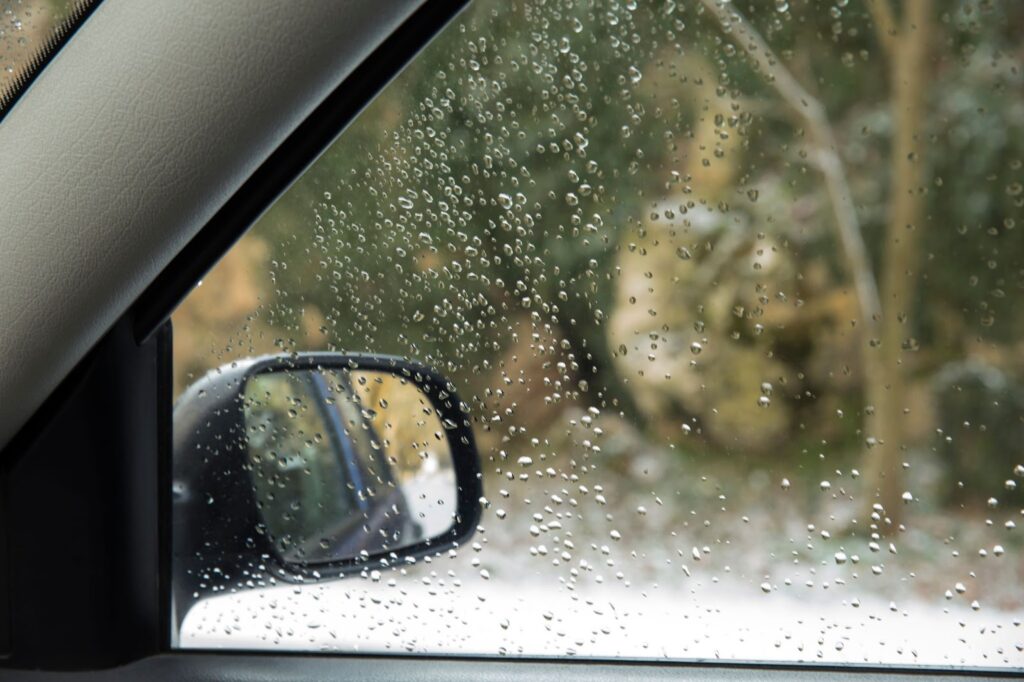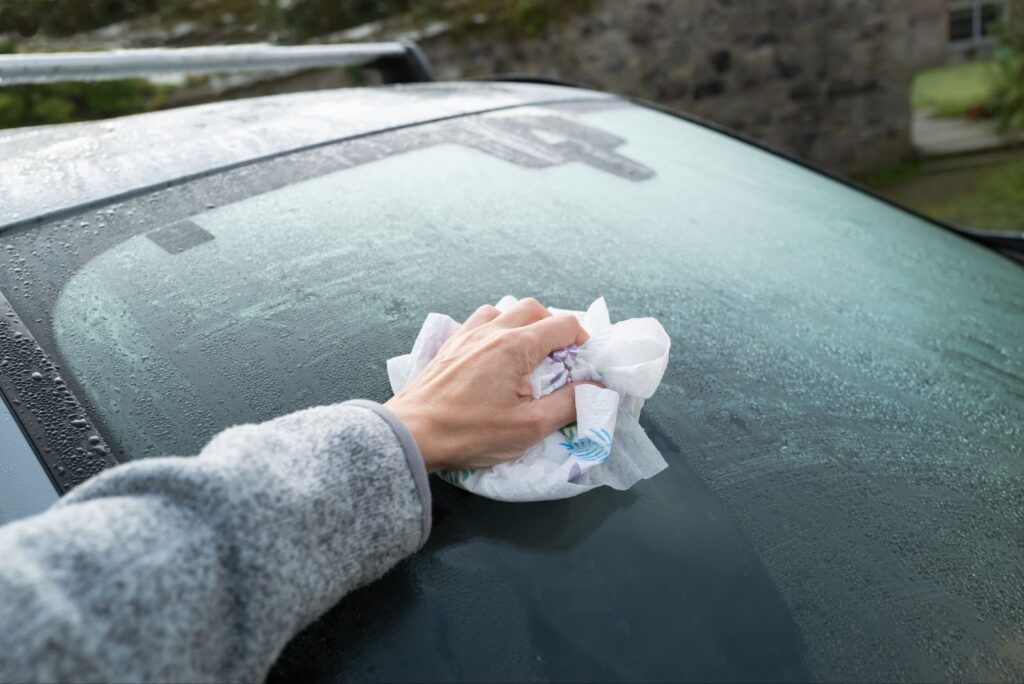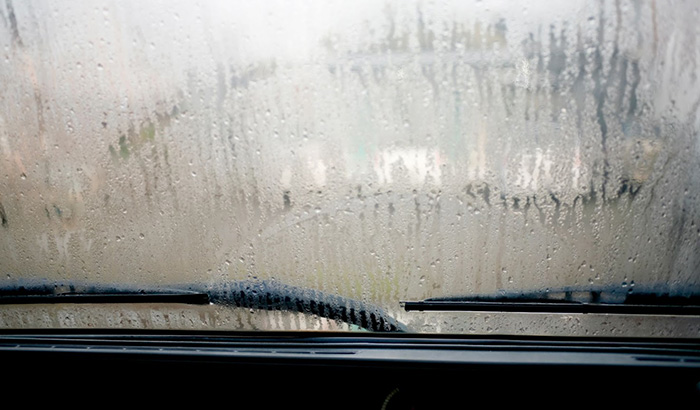Dealing with windshield condensation is a common challenge for drivers, often leading to reduced visibility and a need for timely solutions. This blog is your reliable guide in addressing and preventing your car’s windshield from fogging up. We’ll delve into the reasons behind condensation, providing clear, practical steps to keep your windshield clear in various conditions.
From quick fixes for those early morning starts to preventative measures that help maintain visibility in the long run, we’ve gathered the essential information you need. Stay with us as we offer dependable advice to ensure your driving experience remains safe and unobstructed, no matter the weather.
What is windshield condensation?
Have you ever walked outside on a chilly morning, only to find your car’s windshield covered in a layer of foggy mist? We’ve all been there!
Windshield condensation occurs when warm, humid air inside your car comes into contact with the cold surface of your windshield. This sudden change in temperature causes the water vapor in the air to transform into tiny droplets of water, which then cling to the glass. This is similar to how dew forms on plants in the early morning.
Several factors contribute to windshield condensation. One primary factor is the difference in temperature between the inside and outside of your car. If it’s cold outside, the warmth from your car’s heater will create a stark temperature contrast. Additionally, if the air inside your car is too humid, the likelihood of condensation forming on your windshield increases.
Did you know that our breath also contributes to windshield condensation? When we breathe out, we release warm, moist air that contains water vapor. If this moisture comes into contact with the cold windshield, condensation will occur, much like when you breathe on a cold window and create fog.
So, there you have it. That’s how windshields get fogged up. Now that we know what causes this problem, let’s talk about some simple yet effective ways to address this issue. With a few easy steps, you’ll be able to prevent condensation from forming and ensure a clear view through your windshield.

How to remove interior windshield condensation
Removing interior windshield condensation helps maintain clear visibility while driving. Here’s a step-by-step guide to effectively remove condensation from the inside of your windshield:
1. Start the engine: Begin by starting your car’s engine, as most of the following steps require the car to be running to utilize the climate control system.
2. Activate the defroster: Turn on the defrost setting on your vehicle’s climate control system. Set it to blow warm air onto the windshield. This helps raise the temperature of the glass, reducing the temperature difference that causes condensation.
3. Adjust the A/C: While it may seem counterintuitive, turn on the air conditioning. The A/C system helps remove moisture from the air inside the car, which in turn reduces humidity levels and helps to clear the windshield faster.
4. Open the windows slightly: If weather permits, crack open a few windows for a short period. This helps equalize the air temperature inside and outside of your car, reducing condensation.
5. Use the rear defogger: If your car is equipped with a rear window defogger, turn it on, too. This helps clear the rear window and aids in balancing the temperature and humidity levels inside the car.
6. Wipe the windshield: If the condensation doesn’t clear quickly, use a clean, dry microfiber cloth to gently wipe the windshield. Avoid using your hands or dirty cloths, as they can smear the glass and leave residue.
7. Apply anti-fog products: For a more long-term solution, consider applying an anti-fog product to the interior of your windshield according to the manufacturer’s instructions. These products create a thin film on the glass that prevents water molecules from forming large droplets, reducing the likelihood of condensation.
8. Maintain low interior humidity: Regularly check for sources of moisture inside your car, such as wet floor mats or clothing. Remove them from the vehicle or make sure they are completely dry to prevent excessive humidity levels.
By following these steps, you can effectively remove interior windshield condensation, ensuring clear visibility and safer driving conditions, especially during colder months or in humid environments.

How to remove exterior windshield condensation
1. Assess the situation
Before you jump into action, take a moment to assess the situation. Exterior windshield condensation usually occurs when the air outside is cooler than the temperature inside your car. This happens on chilly mornings or in areas with high humidity. By understanding the cause, you’ll be able to better combat the condensation.
2. Turn on the defroster
Look for the defroster button or switch on your dashboard and turn it on. Most vehicles have multiple defrost settings, so choose the one that suits your needs. The defroster works by blowing warm air onto the windshield, helping to evaporate the condensation quickly.
3. Adjust the temperature
While the defroster is running, adjust the temperature inside the car to a comfortable level. By increasing the warmth, you create a temperature difference that actively fights the condensation on the windshield. Experiment with different temperature settings to find what works best for you.
4. Use the air conditioning
Surprisingly, your air conditioning system isn’t only for hot summer days! It can be incredibly useful in combating exterior condensation as well. Turn on your air conditioning while the defroster is running simultaneously. The cool air from the air conditioner will help reduce the humidity inside the car, minimizing the chances of condensation forming on the windshield.
5. Crack open the windows
To further aid in the battle against windshield condensation, crack open your car windows slightly. By doing so, you allow some fresh air to circulate inside the vehicle, reducing the humidity level even more. This simple trick can make a big difference in preventing condensation buildup.
6. Clean the windshield
A clean windshield is a happy windshield! Use a high-quality glass cleaner and a microfiber cloth to clean the exterior of your windshield. Removing any dirt or grime will help prevent additional condensation from forming.
If you notice any stubborn spots, give them some extra attention. A clear and clean windshield will not only look better but will also be less prone to condensation.
7. Park smartly
Where you park your car can also affect the formation of exterior condensation on your windshield. Try to park in areas where the car is exposed to sunlight, especially during the early morning hours. Sunlight helps to warm up the glass and evaporate any excess moisture, minimizing condensation buildup.
Remember, prevention is key! Taking steps to avoid excessive moisture buildup in your car will help prevent exterior windshield condensation altogether.
Preventative measures for windshield condensation
Now you know how to get rid of windshield condensation, but what about minimizing it or preventing it altogether? Of course, it might not be realistic to envision never having windshield condensation.
But by taking the right steps, you can drastically reduce how much condensation there is and how often you have to deal with it. Let’s take a closer look at the steps that will help you achieve that.
1. Use your A/C: As we mentioned earlier for reducing condensation, using your A/C will also help prevent it from forming altogether. Even in colder weather, use your car’s air conditioning system periodically. It works as a dehumidifier, removing moisture from the air inside your car, which helps prevent condensation.
2. Regularly replace cabin air filters: Cabin air filters that are clogged or dirty restrict airflow and contribute to higher humidity levels inside your vehicle. Regular replacement ensures better air quality and circulation, reducing the risk of condensation.
3. Keep the windshield clean: Regularly clean both the inside and outside of your windshield. Dirt and residue attract moisture, leading to more condensation. Use a glass cleaner and a microfiber cloth for effective cleaning.
4. Check for leaks: Water entering your vehicle from leaks will significantly increase interior humidity levels, leading to condensation. Regularly check the condition of your car’s seals around windows, doors, and the sunroof (if you have one) and repair any leaks promptly.
5. Use waterproof floor mats: Moisture can accumulate from snow, rain, or spills on floor mats, contributing to interior humidity. Waterproof or rubber mats will help prevent this moisture buildup.
6. Ventilate your car: Whenever possible, especially after parking in damp conditions or when storing wet items in the vehicle, leave windows slightly open (weather permitting) or use ventilation to circulate air and reduce humidity levels.
7. Use moisture absorbers: Products like silica gel packets, moisture absorbers designed for cars, or even a sock filled with cat litter can help absorb excess moisture in your vehicle, reducing the likelihood of condensation.
8. Apply anti-fog products: There are various anti-fog sprays and treatments available that you can apply to the interior of the windshield. These products create a thin film that prevents water molecules from forming large droplets, thus reducing fogging.
In addition to condensation, if you ever have winter-related issues with your windshield, check out How to Quickly Address Winter-Related Windshield Problems.
Utah Mobile Auto Glass
For a clear path ahead, trust Utah Mobile Auto Glass for all your windshield needs. Whether you’re facing persistent condensation issues or need expert advice on maintaining your windshield, our team is here to ensure your driving experience is safe and unobstructed. Don’t let foggy windows cloud your journey.
Reach out to Utah Mobile Auto Glass today, and let us provide you with the solutions and services to keep your view crystal clear, no matter where the road takes you.








